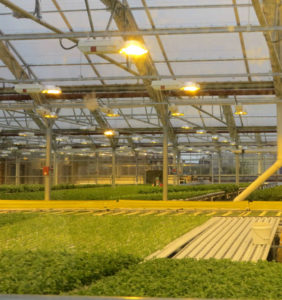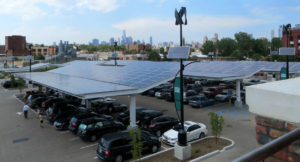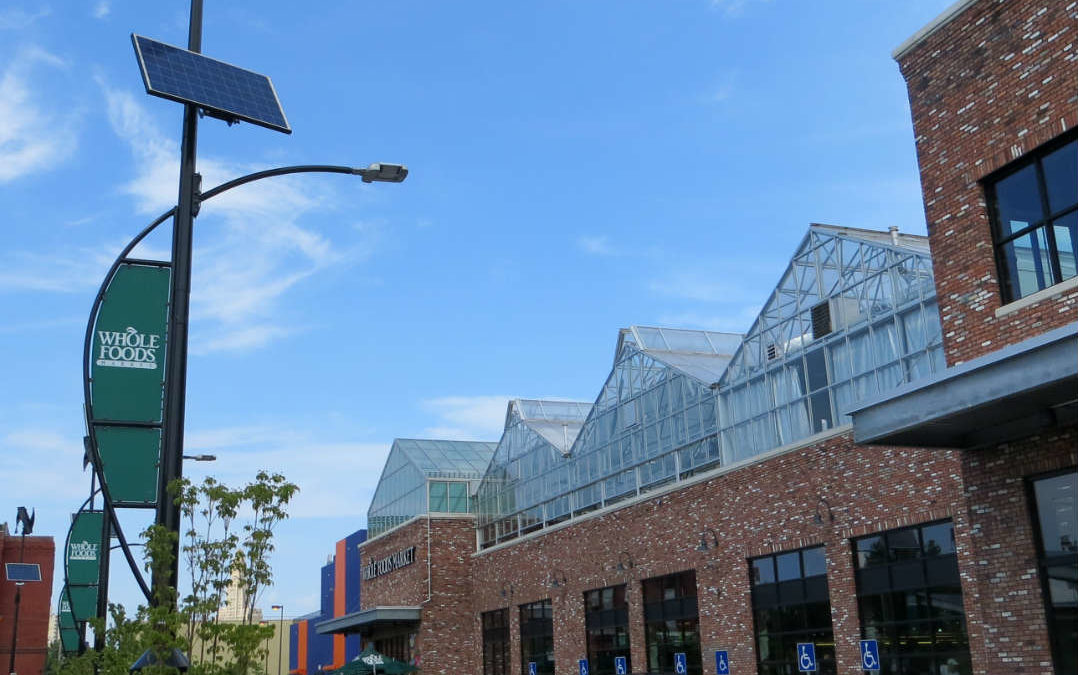I was wowed when visiting the newly opened Whole Foods store located on the Gowanus Canal in Brooklyn, New York! The high-end, natural and organic foods market is strategically located in an up’n coming area of Brooklyn, despite the fact that the Gowanus Canal is a Superfund site and one of the nation’s most “extensively contaminated water bodies” according to the U.S. Environmental Protection Agency. The South Brooklyn area is rebounding with youthful energy, as it is more affordable and hip, as evidenced by my 30-year old niece and her husband living there despite having jobs in Manhattan.
Rooftop Farm

Gotham Greens 20,000 Square Foot Greenhouse
Touring the store was on top of my New York City “must do” list as I had heard that the 20,000 square foot Gotham Greens rooftop farm grows more than enough greens and tomatoes to supply the thirteen metropolitan New York Whole Foods stores with surplus product to sell to other stores, too. The pesticide-, insecticide-, and herbicide-free hydroponically grown produce uses 1/10th the amount of water and produces 20 times the yield of in-the-ground grown and harvested product. The climate controlled environment beneath the louvered glass enclosure is vigilantly monitored and adjusted by Gotham Greens staff to provide just the correct amount of light, air, and heat every day, depending on the growing season.
Gotham Greens leased a bare rooftop allowing them to construct the greenhouse and command central, where computers, sensors, and attentive personnel grow kale, basil, lettuces, other greens, and tomatoes year around. Some items such as red lettuce grow better in the autumn and become a seasonal Gotham Greens feature. Every week, 10,000 beneficial bugs are released beneath the glass, to ensure the produce remains pest free while guaranteeing pollination. Crops are harvested every three to six weeks, while tomatoes are picked daily, year-round from long draping indeterminate vines that grow across the greenhouse. Packaged products are “shipped” downstairs and delivered to twelve other Whole Foods stores.
More Sustainable Attributes
The edible rooftop was incredible, but all the other attributes made the store an outstanding example of pushing the envelope on sustainability into a realm that is testing new ideas and making them plausible and perhaps even feasible for future forward thinking real estate projects. Having a few moments to look out over the Whole Foods grounds from the second store outdoor balcony before our tour began, I took in all the advanced thinking, cutting edge innovations and was energized by new possibilities in future development projects.
J’aime Mitchell our Whole Foods guide began by talking about the store’s infrastructure, which is mundane to many and often doesn’t get the respect it deserves, except from engineers like me. Only 5% of the on-site stormwater runoff leaves the project site, as the rest is captured for re-use or infiltrates. The parking surface is built with porous pavers, which immediately return rainwater into the ground and eventually the canal. Cars are parked beneath solar panel canopies that meet 25% of the store’s energy needs, but also serve as a rainwater collection system. The captured stormwater flows and in-store hand-washing wastewater are directed to a large storage tank beneath the parking lot creating a graywater system that is cleaned and filtered and used for toilet flushing and irrigation water. The stormwater and graywater management systems are impressive as water was used twice, but there was more!

Whole Foods parking area with Manhattan skyline
The parking lot was dotted with an overhead light system that is totally powered by solar and wind. As the wind blows or the sun shines the battery packs beneath each light standard are adequately recharged such that no auxiliary power source is needed for a securely illuminated lot. Further, human power brings a multitude of customers by foot and bike evidenced by the endless line of bike racks that were moderately filled during a mid-week non-prime time and a smaller than average parking lot. J’aime said that additional bike racks had been added to accommodate the weekend cycle traffic.
And There is More
Entering the store vestibule, which is an important buffer between a bitter cold winter or a steamy hot summer and a pleasant shopping environment, the gaze travels upwards to the greenhouse’s tomato section. Draping vines fill the space 20 feet above eye-level, growing fresh bursts of year-round sunshine.
In the produce section, Gotham Green products are featured along with a multitude of other locally grown fruits and vegetables in an interior setting designed to recognize the region’s historic past. Brick facades were evident throughout the store such as in the upstairs bar/eating establishment and adjacent to the produce section that were repurposed from a Newark, New Jersey Westinghouse factory that had been razed brick by brick. Board walks and building materials from the ravages of the Superstorm Sandy were crafted into benches, wainscotings, and produce bins rather than landfilled. Admirably, Whole Foods took historically significant materials from tragedy and times past reintegrating them into a vision of beauty and purpose.
Finally, the Brooklyn Whole Foods took the initiative to install a refrigeration system that only uses carbon dioxide rather than more typical synthetic refrigerants. Reaching back into early 1900’s technology, European and Canadian grocers have been thwarting conventional synthetic refrigeration systems as they can leak into the atmosphere and are detrimental to the environment by hurting the ozone layer or contributing to climate change or both. Whole Foods has now joined this trend and installed their first “old is new” carbon dioxide refrigeration system. One aspect of this system is the refrigerated products being protected by clear, plastic, vertical drapery which allow the coolness to stay in the case rather than chill the aisles. Customers must reach through the curtain to their milk or other perishable product, as I did as a child.
Besides all the environmental and sustainable innovations, the store was light, airy, and inviting. Once back in Seattle, I couldn’t stop talking about the incredible Whole Foods–Brooklyn and how it is pulling the future of sustainability, reuse, and locally-grown into today.
Kathryn Gardow, P.E., is a local food advocate, land use expert and owner of Gardow Consulting, an organization dedicated to providing multidisciplinary solutions to building sustainable communities. Kathryn has expertise in project management, planning, and civil engineering, with an emphasis on creating communities that include food production. Kathryn is a Washington Sustainable Food and Farming Network board member. Kathryn’s blog muses on ways to create a more sustainable world.

